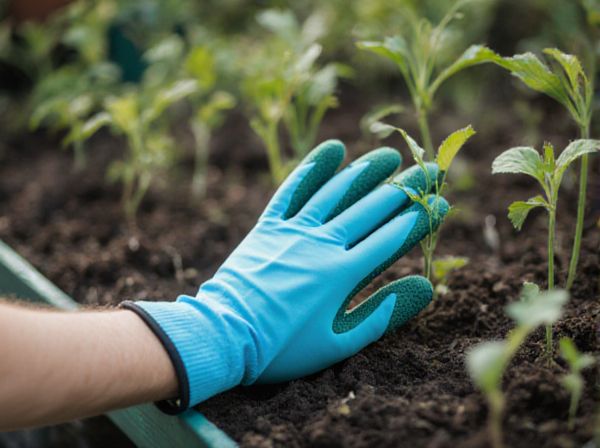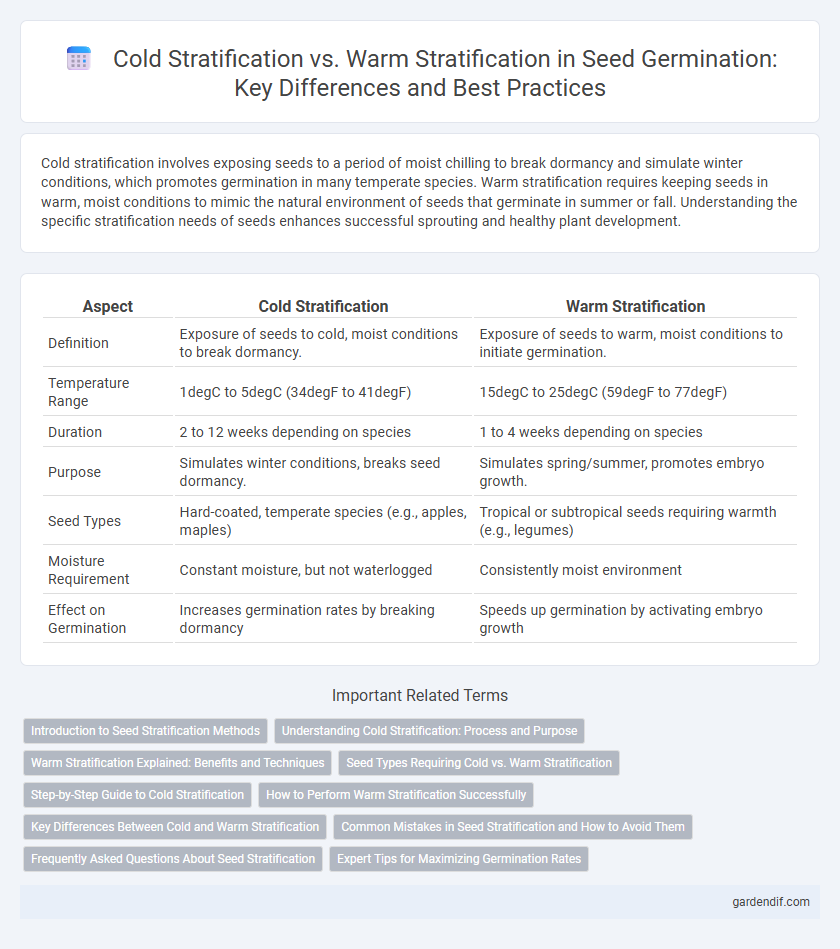
Cold stratification vs Warm stratification Illustration
Cold stratification involves exposing seeds to a period of moist chilling to break dormancy and simulate winter conditions, which promotes germination in many temperate species. Warm stratification requires keeping seeds in warm, moist conditions to mimic the natural environment of seeds that germinate in summer or fall. Understanding the specific stratification needs of seeds enhances successful sprouting and healthy plant development.
Table of Comparison
| Aspect | Cold Stratification | Warm Stratification |
|---|---|---|
| Definition | Exposure of seeds to cold, moist conditions to break dormancy. | Exposure of seeds to warm, moist conditions to initiate germination. |
| Temperature Range | 1degC to 5degC (34degF to 41degF) | 15degC to 25degC (59degF to 77degF) |
| Duration | 2 to 12 weeks depending on species | 1 to 4 weeks depending on species |
| Purpose | Simulates winter conditions, breaks seed dormancy. | Simulates spring/summer, promotes embryo growth. |
| Seed Types | Hard-coated, temperate species (e.g., apples, maples) | Tropical or subtropical seeds requiring warmth (e.g., legumes) |
| Moisture Requirement | Constant moisture, but not waterlogged | Consistently moist environment |
| Effect on Germination | Increases germination rates by breaking dormancy | Speeds up germination by activating embryo growth |
Introduction to Seed Stratification Methods
Cold stratification and warm stratification are essential seed treatment methods used to break dormancy and promote germination by mimicking natural environmental conditions. Cold stratification involves exposing seeds to low temperatures, typically between 1degC and 5degC, for several weeks to simulate winter. Warm stratification requires maintaining seeds at moderate temperatures around 15degC to 25degC, often combined with moisture, to replicate early spring or fall conditions that trigger seed sprouting.
Understanding Cold Stratification: Process and Purpose
Cold stratification mimics natural winter conditions by exposing seeds to prolonged chilling temperatures, typically between 1degC and 5degC, to break dormancy and trigger germination. This process alters hormonal balances within the seed, reducing abscisic acid levels and increasing gibberellin activity, essential for overcoming physical or physiological dormancy. Cold stratification is critical for species native to temperate climates, such as apple (Malus domestica) and oak (Quercus spp.), ensuring seeds germinate at optimal times for seedling survival.
Warm Stratification Explained: Benefits and Techniques
Warm stratification involves exposing seeds to consistent, warm temperatures to simulate natural germination conditions, crucial for breaking dormancy in certain species like tropical plants. This technique enhances enzyme activity and hormone balance, promoting faster and more uniform seedling emergence. Common methods include moist incubation at 20-30degC and alternating light exposure to mimic natural seasonal cues, improving germination rates and overall plant vigor.
Seed Types Requiring Cold vs. Warm Stratification
Seeds from temperate regions, such as apple, oak, and pine, typically require cold stratification to break dormancy by simulating winter conditions. In contrast, tropical and subtropical seeds like mango, avocado, and citrus often need warm stratification to mimic consistent moist and warm environments for germination. Understanding these distinct stratification requirements is crucial for optimizing seed germination and improving plant propagation success.
Step-by-Step Guide to Cold Stratification
Cold stratification involves exposing seeds to moist, cold conditions, typically between 1degC and 5degC, for a specific period to break seed dormancy and simulate winter. Begin by soaking seeds in water for 24 hours, then mix them with a moist medium like peat moss or sand inside a sealed plastic bag. Store the bag in the refrigerator for 4 to 12 weeks depending on the species, checking periodically to prevent mold and drying out before planting the seeds in appropriate soil.
How to Perform Warm Stratification Successfully
To perform warm stratification successfully, maintain seeds in a moist environment at temperatures between 68degF and 77degF for four to twelve weeks, depending on the species. Use a sterile medium such as damp peat moss or vermiculite to prevent mold and ensure consistent moisture without waterlogging. After the warm period, gradually transition seeds to cold stratification or directly to germination conditions to optimize sprouting rates.
Key Differences Between Cold and Warm Stratification
Cold stratification simulates natural winter conditions by exposing seeds to low temperatures, typically between 1degC and 5degC, to break seed dormancy and promote germination. Warm stratification involves maintaining seeds at moderate temperatures, around 15degC to 25degC, mimicking autumn or early spring conditions to stimulate metabolic processes and prepare seeds for growth. The key differences lie in temperature requirements, duration of treatment, and the types of seeds suitable for each method, with cold stratification primarily used for temperate-climate species and warm stratification favored for seeds requiring mild seasonal cues.
Common Mistakes in Seed Stratification and How to Avoid Them
Cold stratification requires exposing seeds to cold, moist conditions to break dormancy, while warm stratification involves warm, moist conditions before cold treatment. Common mistakes include inconsistent moisture levels, improper temperature control, and insufficient stratification duration, which can hinder germination success. To avoid these errors, maintain steady humidity, use accurate temperature settings (cold stratification around 1-5degC, warm stratification around 15-25degC), and follow species-specific timing guidelines.
Frequently Asked Questions About Seed Stratification
Cold stratification mimics natural winter conditions by exposing seeds to low temperatures, breaking dormancy and promoting germination in species like apple, cherry, and lilac. Warm stratification involves maintaining seeds in moist, warm environments to stimulate embryo development, often used for tropical or subtropical seeds such as avocado or mango. Understanding the specific stratification requirements, including duration and temperature ranges, is crucial for successful seed propagation and maximizing germination rates.
Expert Tips for Maximizing Germination Rates
Cold stratification mimics natural winter conditions by exposing seeds to low temperatures between 1degC and 5degC for 4 to 12 weeks, effectively breaking seed dormancy and enhancing germination rates for species like apple and maple. Warm stratification involves maintaining seeds at temperatures around 15degC to 20degC for a shorter period, typically 2 to 6 weeks, to soften seed coats and activate enzymes, ideal for tropical or subtropical plant seeds. Experts recommend combining warm stratification followed by cold stratification for species with double dormancy, and monitoring moisture levels closely throughout the process to prevent fungal growth and ensure optimal seed viability.
Cold stratification vs Warm stratification Infographic

 gardendif.com
gardendif.com